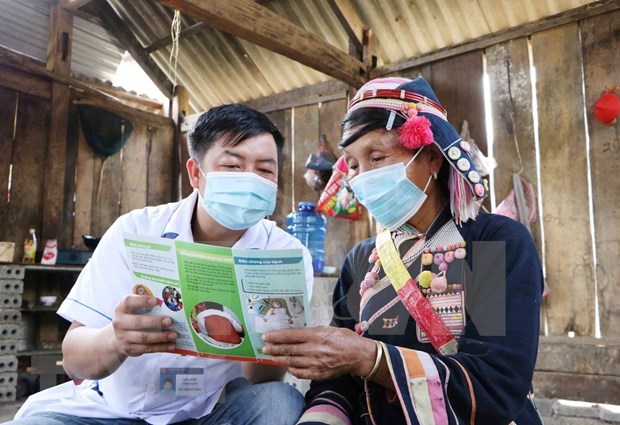Vietnam- successful model in healthcare sector
Hanoi (VNA) - President Ho Chi Minh sent a letter to the Health Staff Conference on February 27, 1955. The date was chosen the Vietnam Physicians’ Day.
On this occasion, Associate Professor Phan Le Thu Hang, deputy director of the health ministry’s Department of Financial Planning and director of the health partnership programme with the WHO, talks to the Vietnam News Agency about the achievements of the Vietnamese healthcare sector.
- Vietnam is highly valued by the United Nations and international organisations for its achievements in the implementation of the Millennium Development Goals (MDGs) in the healthcare sector. Could you tell us about these goals?
Associate Professor Phan Le Thu Hang: The MDGs, which consist of eight goals and 21 specific targets, are considered a global commitment agreed by all 189 member states of the United Nations, including Vietnam. The countries committed to achieving the goals by 2015 at the UNs Millennium Summit which took place from September 6 to 8, 2000.
Reviewing 15 years of MDGs implementation, Vietnam has basically achieved its goals in health.
 A surgery at the High-Tech Center - Saint Paul General Hospital (Hanoi). (Photo: Hoang Hieu/VNA)
A surgery at the High-Tech Center - Saint Paul General Hospital (Hanoi). (Photo: Hoang Hieu/VNA)Vietnam is assessed by the United Nations and international organisations to be a bright spot and a successful model in the implementation of the MDGs in the health sector with impressive achievements.
Firstly, Vietnam has achieved or surpassed 16 out of 17 targets, with one target (the under-five-year old child mortality rate) almost achieved. Most of Vietnam’s indicators have been achieved, many of which are much better than the global average.
Secondly, Vietnam has completed the goals in the context of very limited resources regarding total health expenditure per capita.
- Vietnam has been praised as a miracle in COVID-19 prevention work. How do you view this assessment?
Associate Professor Phan Le Thu Hang: Vietnam is considered by the international community the most successful country for effective and low-cost COVID-19 prevention and control.
With the strategy of "preventing, detecting, quarantine, localising, containing and treating," Vietnam has succeeded in the early prevention of transmission sources, early detection of infection cases, fast tracing, zoning, quarantine as well as treating cases.
Thanks to the strategy, Vietnam is able to contain single cases, community cases, or outbreaks at healthcare facilities in the shortest time possible.
Vietnam was one of the first four countries to be able to isolate the new strain of the coronavirus. In only a short time, Vietnam proactively made ventilators, diagnostic biologicals and started testing COVID-19 vaccines.
 Taking samples to serve COVID-19 prevention (Photo: VNA/VNP)
Taking samples to serve COVID-19 prevention (Photo: VNA/VNP)Over the years, the Vietnamese health sector has prioritised prevention over treatment with a strong political commitment and a very high level of consensus among the public.
Vietnam has a grassroots healthcare network and an expanded and effectively-operated public health disaster prevention/response system.
These are fundamental advantages that few countries have, giving Vietnam a huge advantage over most other countries in dealing with new outbreaks.
Vietnam has also developed a wide and efficient grassroots healthcare network with the capacity to provide essential healthcare services and to implement basic disease prevention measures for the community.
Our grassroots health network has many advantages compared to primary healthcare networks of many countries. It covers all residential areas, even areas that are geographically difficult to access.
The network is closely connected with the community through the role of communal clinics and local healthcare workers.
Services such as medical examination and treatment, family planning prevention and physical rehabilitation are integrated into the network.
The grassroots health network has operated very effectively during the COVID-19 pandemic, helping with tracing, screening, quarantine, taking testing samples, disinfection and on-site treatment.
- The Vietnamese health sector keeps innovating to develop itself into a strong system. So what is the most important goal of the health sector now?
Associate Professor Phan Le Thu Hang: The Ministry of Health has determined renovating grassroots healthcare to look towards universal health coverage is one of the most important goals.
It aims to ensure all people have access to essential health services when needed, without incurring financial risks.
Universal healthcare coverage aims to ensure equity in accessing healthcare service, optimising resources and improving financial protection ability.
Universal health coverage remains a challenging goal for all healthcare systems, especially in countries with low and middle incomes per capita.
Currently, it is thought no country can achieve universal health coverage without a strong primary healthcare system and primary healthcare is considered a smart option and a key to realising universal healthcare coverage.
 Medical staff of Huoi Luong commune’s health clinic, Phong Tho district, Lai Chau province popularises information on health policy and disease prevention (Photo: Nguyen Oanh/VNA)
Medical staff of Huoi Luong commune’s health clinic, Phong Tho district, Lai Chau province popularises information on health policy and disease prevention (Photo: Nguyen Oanh/VNA)In Vietnam, the grassroots healthcare system reform has been identified as a priority to hit the goal of universal health coverage and sustainable development goals in the healthcare sector.
In recent years, the Ministry of Health has worked closely with localities to develop and implement action plans on building and developing the grassroots health network. This effort has yielded positive initial results, including improving service delivery capacity and primary healthcare service quality. The grassroots healthcare system has responded more flexibly and effectively to the increasing trend of chronic and non-communicable diseases. The interaction between healthcare levels has become more flexible and effective, contributing to reducing the overload at the upper levels.
The healthcare sector has also made breakthroughs in the application of IT in public health management./.











